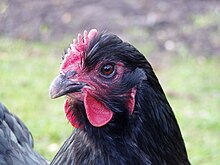
The Silkie is a breed of chicken named for its atypically fluffy plumage, which is said to feel like silk and satin. The breed has several other unusual qualities, such as black skin and bones, blue earlobes, and five toes on each foot, whereas most chickens only have four. They are often exhibited in poultry shows, and also appear in various colors. In addition to their distinctive physical characteristics, Silkies are well known for their calm, friendly temperament. It is among the most docile of poultry. Hens are also exceptionally broody, and care for young well. Although they are fair layers themselves, laying only about three eggs a week, they are commonly used to hatch eggs from other breeds and bird species due to their broody nature.

Cat coat genetics determine the coloration, pattern, length, and texture of feline fur. Understanding how can be challenging because many genes are involved. The variations among cat coats are physical properties and should not be confused with cat breeds. A cat may display the coat of a certain breed without actually being that breed. For example, a Siberian could wear point coloration, the stereotypical coat of a Siamese.
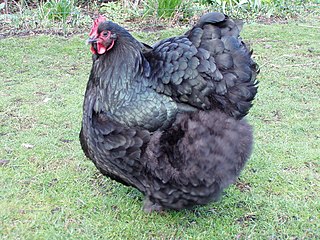
The Orpington is a British breed of chicken. It was bred in the late nineteenth century by William Cook of Orpington, Kent, in south-east England. It was intended to be a dual-purpose breed, to be reared both for eggs and for meat, but soon became exclusively a show bird.
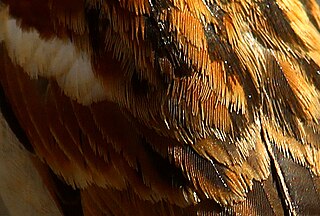
Plumage is a layer of feathers that covers a bird and the pattern, colour, and arrangement of those feathers. The pattern and colours of plumage differ between species and subspecies and may vary with age classes. Within species, there can be different colour morphs. The placement of feathers on a bird is not haphazard, but rather emerge in organized, overlapping rows and groups, and these feather tracts are known by standardized names.
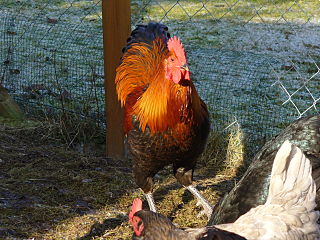
The German Langshan is a breed of chicken developed from the exported Croad Langshan in Germany. It is a large, robust breed of exceptional height. Though most often raised for show, it has practical application as a layer and meat bird, as well. The standard-sized German Langshan is uncommon in both the United States and the United Kingdom, but the bantam form is popular in the latter.

The Barnevelder is a Dutch breed of domestic chicken. It resulted from cross-breeding between local Dutch chickens and various "Shanghai" birds imported from Asia to Europe in the later part of the nineteenth century; these may have been of Brahma, Cochin or Croad Langshan type. It is named for the town and gemeente (municipality) of Barneveld, in Gelderland in the central Netherlands. The hens are good layers of large brown eggs and, unlike some other breeds, continue to lay well during winter.

The cream gene is responsible for a number of horse coat colors. Horses that have the cream gene in addition to a base coat color that is chestnut will become palomino if they are heterozygous, having one copy of the cream gene, or cremello, if they are homozygous. Similarly, horses with a bay base coat and the cream gene will be buckskin or perlino. A black base coat with the cream gene becomes the not-always-recognized smoky black or a smoky cream. Cream horses, even those with blue eyes, are not white horses. Dilution coloring is also not related to any of the white spotting patterns.

The Australorp is a chicken breed of Australian origin, developed as a utility breed with a focus on egg laying and is famous for laying more than 300 eggs. It achieved world-wide popularity in the 1920s after the breed broke numerous world records for number of eggs laid and has been a popular breed in the western world since. It is one of eight poultry breeds created in Australia and recognised by the Australian Poultry Standards. The most popular colour of the breed is black, which is the only colour recognised in the United States of America, but blue and white are also recognised in Australia and the Poultry Club South Africa recognises buff, splash, wheaten laced and golden in addition.

The Brahma is an American breed of chicken. It was developed in the United States from birds imported from the Chinese port of Shanghai, and was the principal American meat breed from the 1850s until about 1930.

The Blue budgerigar mutation is one of approximately 30 mutations affecting the colour of budgerigars. It is part of the genetic constitution of the following recognised varieties: Skyblue, Cobalt, Mauve and Violet.
The German Fallow budgerigar mutation is one of approximately 30 mutations affecting the colour of budgerigars. At least three types of Fallow, the German, English, and Scottish, all named after their country of origin, have been established, although none of these types is common. They are superficially similar, but adult birds may be distinguished by examining the eye. All have red eyes, but the German Fallow shows the usual white iris ring, the eye of the English Fallow is a solid red with a barely discernible iris and the iris of the Scottish Fallow is pink.

Dominant white (W) is a group of genetically related coat color alleles on the KIT gene of the horse, best known for producing an all-white coat, but also able to produce various forms of white spotting, as well as bold white markings. Prior to the discovery of the W alllelic series, many of these patterns were described by the term sabino, which is still used by some breed registries.
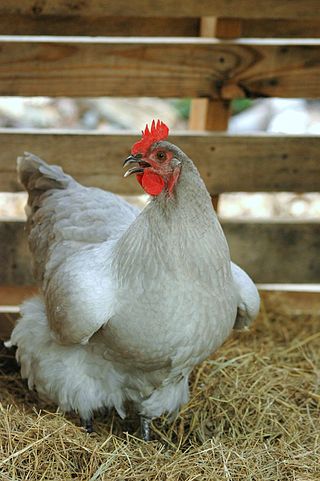
Lavender or self-blue refers to a plumage color pattern in the chicken characterized by a uniform, pale bluish grey color across all feathers. The distinctive color is caused by the action of an autosomal recessive gene, commonly designated as "lav", which reduces the expression of eumelanin and phaeomelanin so that black areas of the plumage appear pale grey instead, and red areas appear a pale buff.

Delayed-feathering in chickens is a genetically determined delay in the first weeks of feather growing, which occurs normally among the chicks of many chicken breeds and no longer manifests itself once the chicken completes adult plumage.
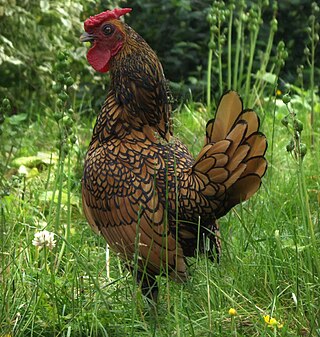
Hen feathering in cocks is the occurrence of a genetically conditioned character in domestic fowl. Males with this condition develop a female-type plumage, although otherwise look and respond as virile males.

In poultry standards, solid white is coloration of plumage in chickens characterized by a uniform pure white color across all feathers, which is not generally associated with depigmentation in any other part of the body.
All chicken breeds recognized by the American Poultry Association are categorized into classes. Standard-sized breeds are grouped by type or by place of origin; bantam breeds are classified according to type or physical characteristics.
Sex-linked barring is a plumage pattern on individual feathers in chickens, which is characterized by alternating pigmented and apigmented bars. The pigmented bar can either contain red pigment (phaeomelanin) or black pigment (eumelanin) whereas the apigmented bar is always white. The locus is therefore often referred to as an ‘eumelanin diluter’ or ‘melanin disruptor’. Typical sex-linked barred breeds include the Barred Plymouth Rock, Delaware, Old English Crele Games as well as Coucou de Renne.

Dogs have a wide range of coat colors, patterns, textures and lengths. Dog coat color is governed by how genes are passed from dogs to their puppies and how those genes are expressed in each dog. Dogs have about 19,000 genes in their genome but only a handful affect the physical variations in their coats. Most genes come in pairs, one being from the dog’s mother and one being from its father. Genes of interest have more than one expression of an allele. Usually only one, or a small number of alleles exist for each gene. In any one gene locus a dog will either be homozygous where the gene is made of two identical alleles or heterozygous where the gene is made of two different alleles.






